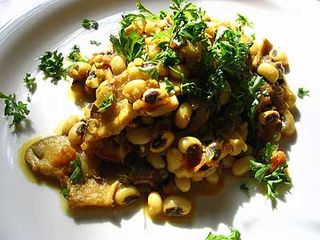HAPPY NEW YEAR!
For many Americans, New Year's means parties, football, and watching the ball drop in Times Square. But to others here and around the world the celebration wouldn't be complete without certain delicious traditional foods.
Black Eyed Peas are a centuries-old New Year's tradition in many countries, served to ensure health, wealth, and peace for the coming year. A traditional southern New Year's dish is Hoppin' John-black eyed peas and ham hocks. An old saying goes, "Eat peas on New Year's day to have plenty of everything for the rest of the year."
The age-old celebration in England and Scotland called the 'First Footing' continues today and always includes a bowl of black-eyed pea soup and a drink to toast the new year at midnight. In the old days, people would gather coals from their hearth just before midnight and set out to visit friends in the first minutes of the new year. The first person to step through the door of the family they were visiting was called the 'first footer' and was believed to set the luck for the coming year. This person would present the spent coals they had gathered to the woman of the house, who would store them away and use them to start the subsequent New Year's fire. The first footer would get kisses and a hot bowl of black-eyed pea soup. First Footing traditions were brought to the U.S. by European immigrants and are still practiced, especially in the South and Northeast. With all variations, black-eyed peas are served for good luck and good health. Sometimes rice and black-eyed peas with cabbage or collard greens are served. The rice symbolizes riches, black-eyed peas for peace, and cabbage or collards represent money in the coming year.
Hoppin John, recipe below
Kwanzaa, the African American holiday beginning December 26 and lasting seven days, often includes black-eyed peas at New Year's. Each evening the celebration focuses on one of seven principles beginning with unity and ending with faith. On New Year's Eve, a feast takes place, with each person bringing a dish to share. These dishes often include baked black-eyed peas, pickled black-eyed peas, black-eye pea salads, and 'Hoppin' John'’ a thick stew with many variations that always include black-eyed peas.
In Texas, the New Year's tradition may include Texas Caviar, a salad made from black-eyed peas, hominy or sweet corn, vegetables, and vinaigrette.
Many Japanese foods also are served to bring health, wealth, and peace to the new year, including soba (buckwheat noodles), black soybeans, and miso soup. In Japan, 'O-Shogatsu' or New Year's begins on December 31 and continues for almost two weeks. Before New Year's Day, all bills are paid or current, and houses are cleaned from top to bottom, sweeping out the old year's energy. Everyone enjoys a simple bowl of long-cut soba noodles in a broth made only with water, kombu sea vegetable, and shoyu soy sauce garnished with scallions from ten minutes to midnight. It is eaten through the first few minutes of the New Year to ensure longevity and prosperity.
Cotechino Con Lenticchie
In Italy, people welcome the New Year by tossing old things out of their windows to make room for the new and lucky to enter their households and lives in the year to come. The Italian people eat a dish called Cotechino Con Lenticchie: pork sausage served over lentils. This dish is consumed because of the fatty, rich pork sausage and lentils in the dish. Cotechino sausage symbolizes abundance because they are rich in fat, while the coin-shaped lentils symbolize money.
Hoppin John
Makes six servings
chefgeorgehirsch.com | George Hirsch Lifestyle
1 pound dried black-eyed peas
2 ham hocks, smoked
2 medium onions, chopped
6 cloves garlic, chopped
2 bay leaves
1 cup converted long-grain white rice
10 ounces diced tomatoes with chilies, juices reserved
1 large red bell pepper, finely diced
3 ribs celery, diced
1 jalapeno or Serrano pepper, minced
2 teaspoons paprika
3/4 teaspoon dried thyme leaves
3/4 teaspoon ground cumin
3 scallions, sliced
hot red pepper sauce
In a large pot, combine the black-eyed peas, ham hocks, and 6 cups of water. Add 1 chopped onion to the pot along with 3 cloves of garlic and bay leaves. Bring to a boil, reduce the heat to medium-low, and simmer gently until the beans are tender but not mushy, 2 to 2 1/2 hours.
Remove and discard the bay leaves. Remove the hocks, cut off the meat in large shreds, and set the meat aside. Drain the peas reserving the liquid, add enough water to the liquid to make 2 1/2 cups of liquid to cook the rice. Add back to the pot and bring to a boil. Add the rice, cover, and simmer until the rice is almost tender.
In a sauté pan, add olive oil, remaining garlic, onion, bell pepper, celery, and jalapeno pepper. Sauté for two minutes and add paprika, thyme, cumin, and tomatoes. Add the cooked rice along with the peas. Top with sliced scallions and meat from the ham hocks. Serve with hot sauce on the side.













